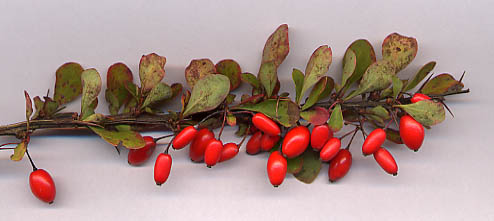- Berberis thunbergii
Taxobox
name = "Berberis thunbergii"

image_width = 240px
image_caption = "Berberis thunbergii" shoot with fruit
regnum =Plant ae
divisio = Magnoliophyta
classis =Magnoliopsida
ordo =Ranunculales
familia =Berberidaceae
genus = "Berberis "
species = "B. thunbergii"
binomial = "Berberis thunbergii"
binomial_authority = DC."Berberis thunbergii" (Japanese barberry or Thunberg's Barberry, also Red Barberry [cite web|url=http://www.djroger.com/red_barberry.htm|title=Moonshine Designs Nursery|accessdate=2008-03-29] ) is a species of "
Berberis ", native toJapan and easternAsia .It is a dense,
deciduous , spinyshrub which grows 1-2 (3) m high. It has deeply grooved, brown, spiny branches with a single (occasionally tridentine) spine (actually a highly modified leaf) at each shoot node. Theleaves are green to blue-green, very small, spatula to oval shaped, 12-24 mm long and 3-15 mm broad; they are produced in clusters of 2-6 on a dwarf shoot in the axil of each spine. Theflower s are pale yellow, 5-8 mm diameter, produced in drooping 1-1.5 cm long umbrella-shaped clusters of 2–5; flowering is from mid spring to early summer. Thefruit is a glossy bright red to orange-red, ovoidberry 7-10 mm long and 4-7 mm broad, containing a singleseed . They mature during late summer and fall and persist through the winter.Cultivation and uses
It is widely grown as an
ornamental plant , both in Japan and elsewhere in the temperate Northern Hemisphere. Numerouscultivar s have been selected, including plants selected for yellow, dark red to violet, or variegated foliage, erect growth (for hedge use), and dwarf size. In recent years it has become aninvasive species in parts of the easternUnited States ; inCanada its cultivation is prohibited as the species can act as a host for "Puccinia graminis " (black rust), a rust disease ofwheat . Currently there are breeding and selection programs aimed at producing cultivars that are either sterile or produce relatively little seed.It is sometimes confused with "Berberis canadensis" (American Barberry), "Berberis vulgaris" (European Barberry), and other deciduous "Berberis" species; it is most readily distinguished by the flowers being produced in
umbel s, notraceme s.Cultivars
*"Berberis thunbergii" 'Atropurpurea Nana' (aka 'Little Favourite' and 'Crimson Pygmy')
*"Berberis thunbergii" 'Aurea'
*"Berberis thunbergii" 'Bagatelle'
*"Berberis thunbergii" 'Bonanza Gold'
*"Berberis thunbergii" 'Golden Ring'
*"Berberis thunbergii" 'Helmond Pillar'
*"Berberis thunbergii" 'Red Chief'
*"Berberis thunbergii" 'Red Pillar'
*"Berberis thunbergii" 'Rose Glow'References
* [http://www.efloras.org/florataxon.aspx?flora_id=1&taxon_id=233500242 Flora of North America: "Berberis thunbergii"] (deals with the species as an introduced plant)
* [http://www.nps.gov/plants/alien/fact/beth1.htm US National Park Service: "Berberis thunbergii"] (deals with the species as an invasive species)External links
* [http://lakecounty.typepad.com/life_in_lake_county/2007/05/berberine_thoug.html Berberine Thoughts] - Informative but non-scholarly essay on Barberry & Berberis (Culture, History and Etymology... and Thunberg).
Wikimedia Foundation. 2010.
